NCERT Solutions For Class 6 History Chapter 7 From A Kingdom To An Empire Exercises
Question 1. Make a list of the occupations of the people who lived within the Mauryan empire.
Answer:
A List Of The Occupations Of The People Who Lived Within The Mauryan Empire:

From a Kingdom to an Empire NCERT Solutions Chapter 7
Question 2. Complete the following sentences:
1. Officials collected __________ from the area under the direct control of the ruler.
Answer: Taxes
2. Royal princes often went to the provinces as __________
Answer: Governors
Read and Learn More NCERT Solutions For Class 6 Social Science
3. The Maury rulers tried to control ___________ and __________ which were important for transport
Answer: Roads, rivers
4. People in forested regions provided the Maury officials with________
Answer: Elephant and forest produce
Question 3. State whether true or false:
1. Ujjain was the gateway to the north-west.
Answer: False
2. Chandragupta’s ideas were written down in the Arthashastra.
Answer: False
3. Kalinga was the ancient name of Bengal.
Answer: False
4. Most Ashokan inscriptions are in the Brahmi script
Answer: True.
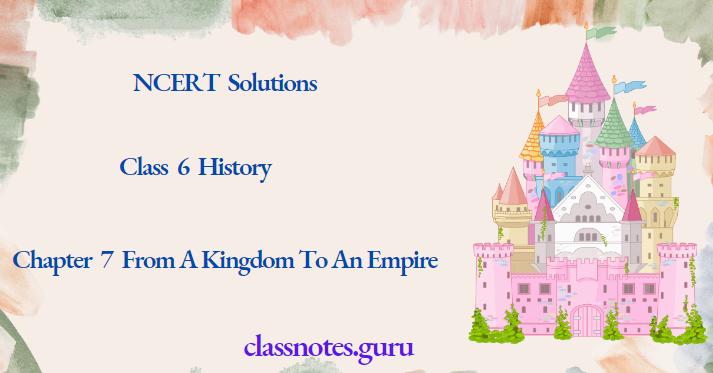
Question 4. What were the problems that Ashoka wanted to solve by introducing Dhamma?
Answer:
The Problems Ashoka Wanted To Solve By Introducing Dhamma Were:
- Respect for other religions and sects.
- Violence or killing of animals.
- Cruelty (He liked mercy or kindness towards slaves and servants).
- To maintain peace in families and among neighbors.
- Respecting one’s elders.
- Treating all creatures with compassion.
Question 5. What were the means adopted by Ashoka to spread the message of Dhamma?
Answer:
Ashoka Adopted The Following Means To Spread The Message Of Dhamma:
- He appointed officials, known as the Dhamma Mahamatta. They went from place to place teaching people about dhamma.
- Ashoka got his messages inscribed on rocks and pillars. He directed his officials to read his messages to those who could not read themselves.
- He also sent messengers to spread ideas about dhamma to other lands, such as Syria, Egypt, Greece, and Sri Lanka.
- Ashoka built roads and planted trees along these roads. He also dug wells and built rest houses.
- Besides he arranged for medical treatment for both, human beings and animals.
Class 6 History Chapter 7 From a Kingdom to an Empire Solutions
Question 6. Why do you think slaves and servants were ill-treated? Do you think the orders of the emperor would have improved their condition? Give reasons for your answer.
Answer:
- I think that slaves and servants were ill-treated. No political authority had favored the proper treatment of slaves and servants.
- Yes, I think the orders of the emperor would have improved the condition of slaves and servants. We can give the following reasons:
- Slaves and servants would have got proper wages and better behavior.
- Their respect in society and working conditions would have improved.
Question 7. Write a short paragraph explaining to Roshan why the lions are shown on our currency notes. List at least one other object on which you see them.
Answer:
- The lions that we see on our currency notes and coins have a long history. They were carved in stone and placed on the top of a massive stone pillar at Samath (near Varanasi).
- Lion from the Ashokan Pillar at Sarnath has four lions though only three can be seen. The fourth one is covered with one of the lions. After India became free, this Ashokan Lion became India’s National Emblem.
- We can see the lions on non-judicial stamp paper also.
Question 8. Suppose you had the power to inscribe your orders, what four commands would you like to issue?
Answer:
I Would Have Like To Issue The Following Four Orders:
- Everyone should respect their elders. Elders should love their youngers.
- Everyone should respect the other’s religion.
- Be kind to your servants and employees.
- Be loyal to your motherland.
Question 9. Name the countries where Ashokan inscriptions have been found.
Answer:
The Countries Were:
- Modem Afghanistan
- Modern Pakistan
- India
- Sri Lanka
- Syria
- Egypt
- Greece
Question 10. Which Indian states were outside the empire?
Answer:
Part of modern Tamil Nadu.
Modern Kerala.
Question 11. How are empires different from kingdoms?
Answer:
Emperors need more resources than kings as empires are larger and need to be protected by big armies. In one empire there may be several kingdoms.
NCERT Solutions For Class 6 History Chapter 7 From A Kingdom To An Empire Very Short Answer Type Questions
Question 1. Who founded the Maury Empire and when?
Answer:
The Mauryan Empire was established by Chandragupta Maurya around 2300 years ago.
Question 2. Who was Kautilya?
Answer:
Kautilya is also known as Chanakya. He was Chandragupta’s minister. He helped him to establish the empire. He wrote “Arthashastra” which has his political ideas.
Question 3. Explain the meaning of the word Dynasty.
Answer:
When members of the same family become rulers one after another the family is called dynasty. The rule is called dynastic rule.
Question 4. Write the names of three rulers of the Mauryan empire and its capital.
Answer:
The Three Rulers Were:
- Chandragupta
- Bindusara
- Ashoka
The capital was at Pataliputra.
Chapter 7 From a Kingdom to an Empire NCERT Class 6
Question 5. Who was Megasthenes?
Answer:
Megasthenes was the ambassador of the Greek ruler Seleucus Nicator. He wrote “Indica” in which he described the rule and rulers of the Mauryan Dynasty.
Question 6. Look at the given picture and write two sentences about it.
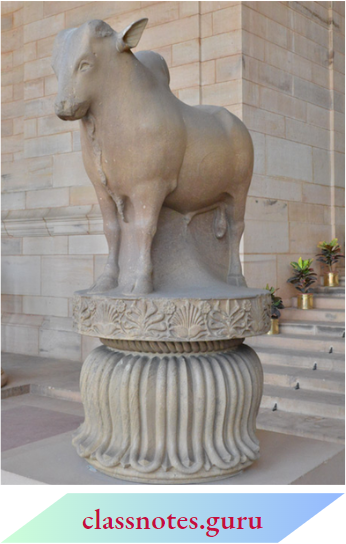
Answer:
- The picture depicts a sculpture of the Rampurwa bull.
- This was part of the Mauryan pillar found at Rampurwa (Bihar).
- It is now been placed in Rashtrapati Bhavan.
NCERT Solutions For Class 6 History Chapter 7 From A Kingdom To An Empire Short Answer Type Questions
Question 1. Mention any three big or prominent cities of the Mauryan empire. Why were these cities popular (or famous)?
Answer:
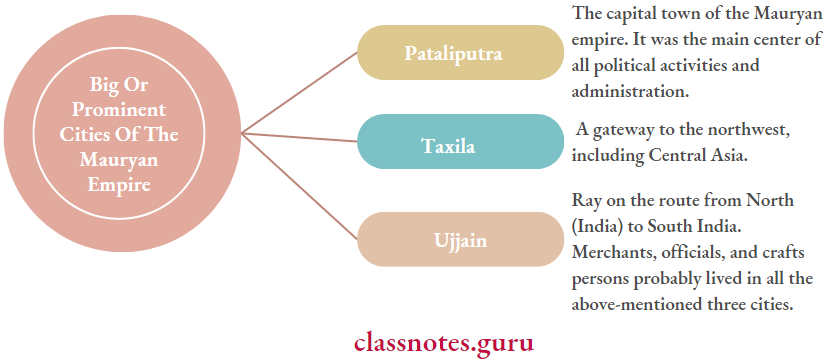
Question 2. Write the main features of the life of the people of the Mauryan empire.
Answer:
The Main Features Of Life Of The People Of The Mauryan Empire Are:
- There were several cities in the empire.
- Mainly emperor and his other family members along with important officials of the kingdom lived in the capital. Merchants, officials, and crafts persons probably lived in the other cities.
- In other areas (other than cities), there were villages of farmers and herders.
- In some areas, such as central India, there were forests. Here people gathered forest produce and hunted animals for food.
- People in different parts of the empire spoke in different languages. They probably ate different kinds of food and wore different kinds of clothes.
- Besides, there were the forest regions. People living in these areas were probably more or less independent. They may have been expected to provide elephants, timber, honey, and wax to Mauryan officials.
Question 3. Discuss the ruling system of the Mauryan empire.
Or
Mention the main features of the administrative system of the Mauryan empire.
Answer:
The Ruling System (Or Administration) Of The Mauryan Empire Is:
- The Mauryan empire was very large. Its different parts were ruled differently.
- The area around Pataliputra was under the direct control of the emperor. This meant that officials were appointed to collect taxes from villages and towns in the area.
- Mauryan government officials also punished those who disobeyed the ruler’s order.
- Most of the Mauryan officials were given salaries.
- Messengers went to and fro. Spies kept a watch on the officials.
- The Mauryan emperor supervised all officials, spies, ambassadors, etc; probably with the help of members of the royal family and senior ministers.
NCERT Solutions for Class 6 History Chapter 7
Question 4. Write three or four sentences about provinces and their administration of the Mauryan Empire.
Answer:
- There were several provinces in the Mauryan empire. Examples: Taxila, Ujjain.
- Each province was ruled by a provincial capital.
- There was some amount of control from Pataliputra. Royal princes were often sent to the provinces as governors.
- In provinces local customs and rules were probably followed.
Question 5. Why was the control of roads and rivers considered important during the Mauryan Age?
Answer:
The Mauryas tried to control roads and rivers. These were important for transport and to collection of whatever resources were available as tax and tribute.
Question 6. Explain the following terms:
- Tribute
- The Brahmi script
Answer:
- Tribute. Tribute was collected as and when it was possible for people who gave a variety of things, more or less willingly.
- The Brahmi script. The Brahmi script was used to write the language of that time (Prakrit). Most of the modern Indian scripts have developed from the Brahmi script.
NCERT Solutions For Class 6 History Chapter 7 From A Kingdom To An Empire Long Answer Type Questions
Question 1. Describe in your own words what Megasthenes had written about the Mauryan Emperor and about the capital city of the Mauryan Empire.
Answer:
Here is a part of Megasthenes’s description of the emperor and the capital city:
- The Emperor
- The occasions on which the emperor appears in public are celebrated * with grand royal processions. He is carried in a golden palanquin (4ld=h1).
- Emperor’s guards rode elephants decorated with gold and silver. Some of the guards carried trees with birds. They flew around the head of the emperor.
- The king (or the emperor) is normally surrounded by armed women. He was afraid that someone might try to kill him.
- The emperor had special servants to taste the food before he ate.
- He never slept in the same bedroom for two nights.
- The Capital City or Pataliputra (or modern Patna)
- The Capital City of the Mauryan empire was Pataliputra (modern Patna). It was a large and beautiful city. It was surrounded by a massive wall. It had 570 towers and 64 gates.
- The houses (of the capital city) were two and three stories, built from wood and mud bricks.
- The emperor’s palace was made of wood. It was decorated with stone carvings. It was surrounded by gardens and enclosures for keeping birds.
Question 2. Discuss Ashoka’s war in Kalinga.
Or
Discuss the main events of Ashoka’s war in Kalinga. What were the effects of this war on him?
Answer:
- Ashoka’s War In Kalinga. Kalinga is the ancient name of coastal Orissa. Ashoka fought a war to conquer Kalinga. About a lakh and a half people were captured. More than a lakh people were killed. After this, he became the emperor of almost the whole of India.
- Impact Of Ashoka’s War In Kalinga
- Ashoka was very horrified when he saw the result of violence and bloodshed. He decided not to fight any more wars.
- Ashoka was very sad. He decided to observe Dhamma and teach others about it as well.
- He believed after this victory in war; that winning people through dhamma was much better than conquering them through force.
- He inscribed his message of peace and love for the future; so that his son and grandson should not think about war. Instead, they should try to think about how to spread dhamma.
From a Kingdom to an Empire: NCERT Solutions and Explanation
Question 3. What was Ashoka’s Dhamma? What did he do in this field?
Answer:
Ashoka’s Dhamma
- Dhamma is the Prakrit word for the Sanskrit term Dharma. Ashoka’s dhamma did not involve worship of a god, or performance of a sacrifice.
- Ashoka felt that like a father, it is his duty to instruct his subjects. He was greatly inspired by the teachings of the Buddha.
- There were numerous problems that troubled Emperor Ashoka. People in the empire followed different religions. This sometimes led to conflict.
Animals were sacrificed. Slaves and servants were ill-treated. Besides, there were quarrels between families and neighbors. Ashoka felt it was his duty to solve these problems. So, he appointed officials, known as the Dhamma Mahamatta who went from place to place teaching people about dhamma.
Ashoka got his messages inscribed on rocks and pillars. He instructed his officials to read the message to those who could not read it themselves.
- Ashoka asked his people to give up useless rituals. He advised his subjects to be gentle with slaves and servants. He asked them to respect their elders.
- Ashoka asked his people to treat all creatures with compassion. They should give gifts to Brahmins and monks.
- Ashoka asked that each one should respect the other’s religion.
- Ashoka sent messengers to spread ideas about dhamma to other lands, such as Syria, Egypt, Greece, and Sri Lanka.
- Ashoka built roads and planted trees along these roads. He dug wells and built rest houses.
Besides, he arranged for medical treatment for both the human beings and the animals.
NCERT Solutions For Class 6 History Chapter 7 From A Kingdom To An Empire Map Skills
On the outline map of India locate the following:
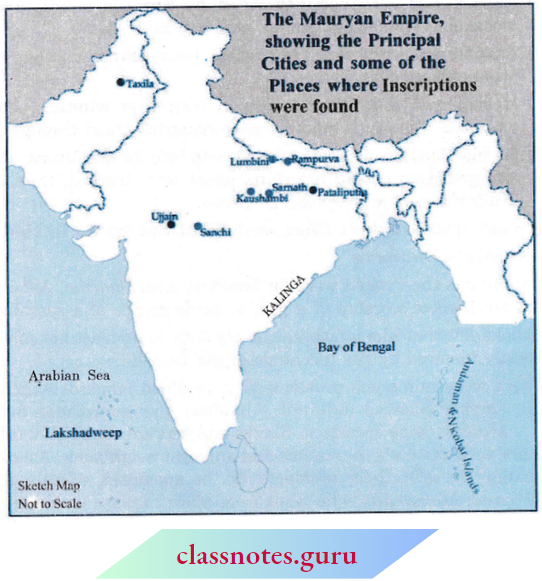
- Pataliputra
- Rampurwa
- Ujjain
- Lumbini
- Taxila
- Kalinga
- Sanchi
- Kaushambi
- Sarnath.
NCERT Solutions For Class 6 History Chapter 7 From A Kingdom To An Empire Multiple Choice Questions
Choose The Correct Answer:
Question 1. How many lions are shown in our national Emblem?
- Two
- Three
- Four
- Five
Answer: 3. Four
Question 2. What was the name of the grandfather of Ashoka?
- Krishna
- Mahavira
- Sidhartha
- Chandragupta Maurya
Answer: 4. Chandragupta Maurya
Question 3. In which book were Chanakya’s ideas written?
- Ramayana
- Mahabharat
- Arthashastra
- None of these
Answer: 3. Arthashastra
Question 4. Who was supported by a wise man named Chanakya?
- Ashoka
- Rindusara
- Chandragupta
- All of these
Answer: 3. Chandragupta
Question 5. Who was Bindusara’s son?
- Chandragupta
- Siddhartha
- Ashoka
- Ram Krishna Pramhans
Answer: 3. Ashoka
NCERT Solutions Chapter 7 From a Kingdom to an Empire
Question 6. In which script were the Ashoka’s inscriptions written?
- Devanagari
- Sanskrit
- Tamil
- Brahmi Script
Answer: 4. Brahmi Script
Question 7. What is the meaning of the word Dhamrna?
- Environment
- Dharma
- Both (1) and (2)
- None of these
Answer: 2. Dharma
Question 8. How many towers supported the massive wall of Pataliputra?
- 670
- 870
- 570
- 470
Answer: 3. 570
Question 9. How many people were killed in the war of Kalinga?
- More than 20,000
- More than 40,000
- More than 60,000
- More than one Lakh
Answer: 4. More than one Lakh
Question 10. Which is the other animal than the lion on the Mauryan Pillar?
- Tiger
- Cow
- Buffalo
- Bull
Answer: 4. Bull
History Chapter 7 NCERT Solutions: From a Kingdom to an Empire
NCERT Solutions For Class 6 History Chapter 7 From A Kingdom To An Empire Objective Type Questions
Question 1. Fill in the blanks with appropriate words:
1. _______ was the founder of the Mauryan empire.
Answer: Chandragupta
2. As per the Arthashastra, the blankets of _________ were very famous.
Answer: North-west
3. Princes were sent as ________ to the provincial capitals.
Answer: Governors
4. Ashoka gave up war after the war of ________
Answer: Kalinga
Class 6 History From a Kingdom to an Empire Notes and Solutions
5. The Sanskrit word for ‘Dhamma’ is _________
Answer: Dharma
Question 2. State whether the given statements are true or false.
1. Arthashastra was written by Ashoka.
Answer: False
2. Gold and precious stones of the South were very famous.
Answer: True
3. The Lions on the currency notes are from Rampurwa Bull.
Answer: False
4. Taxilla and Ujjain were ruled by Pataliputra.
Answer: True
NCERT Class 6 History Chapter 7 Study Material
5. Bulls and lions are shown on the Ashokan pillar.
Answer: True
Question 3. Match the contents of Column A with that of Column B.
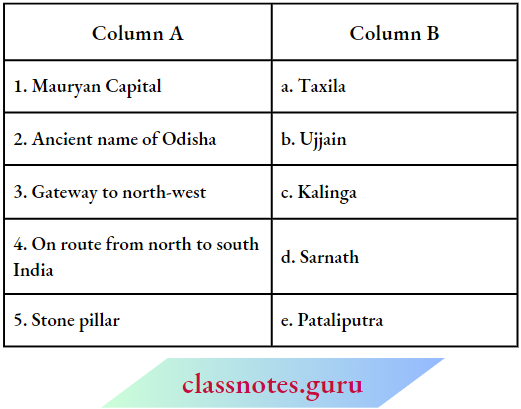
Answer: 1-e, 2-c, 3-a, 4-b, 5-d
